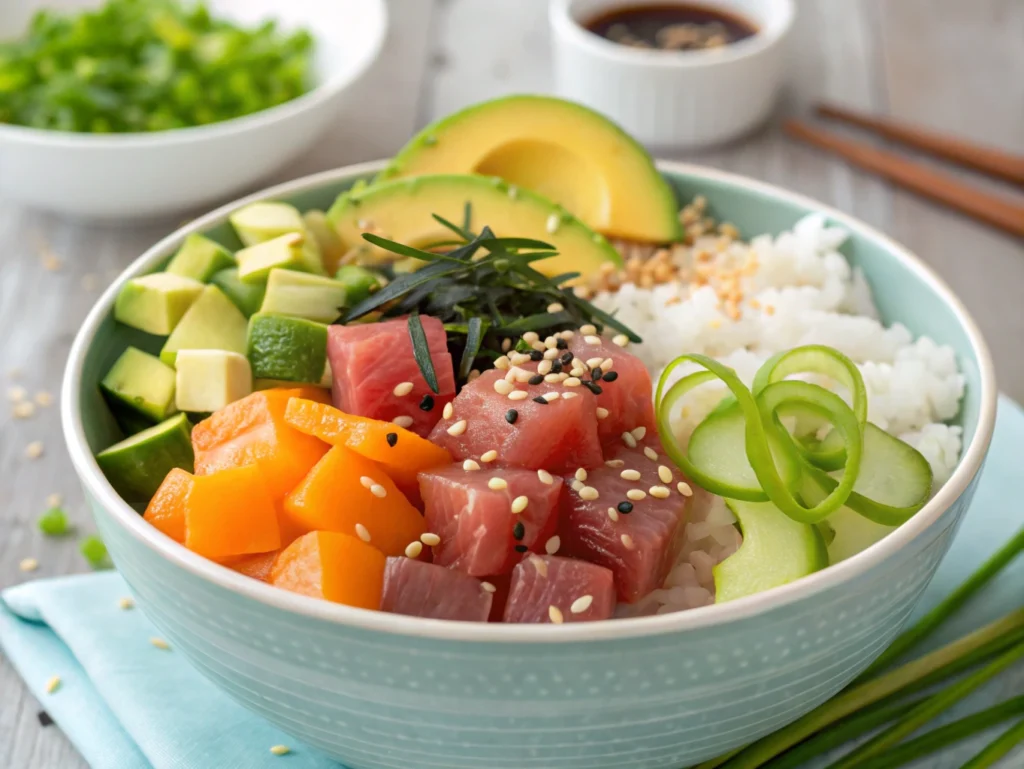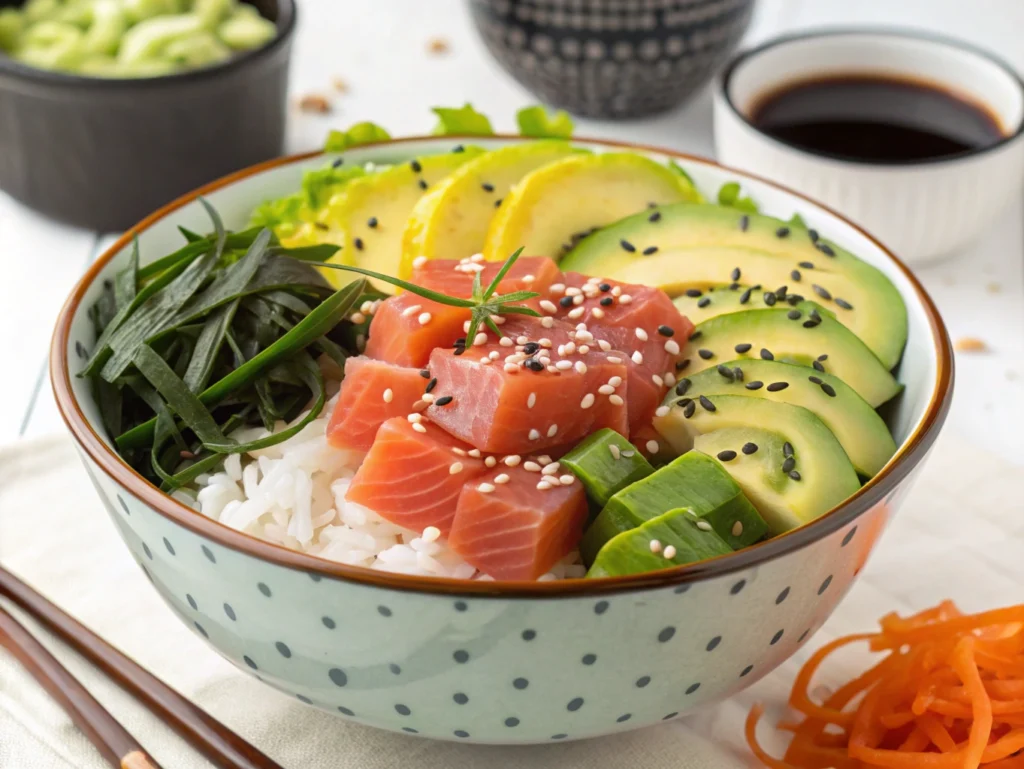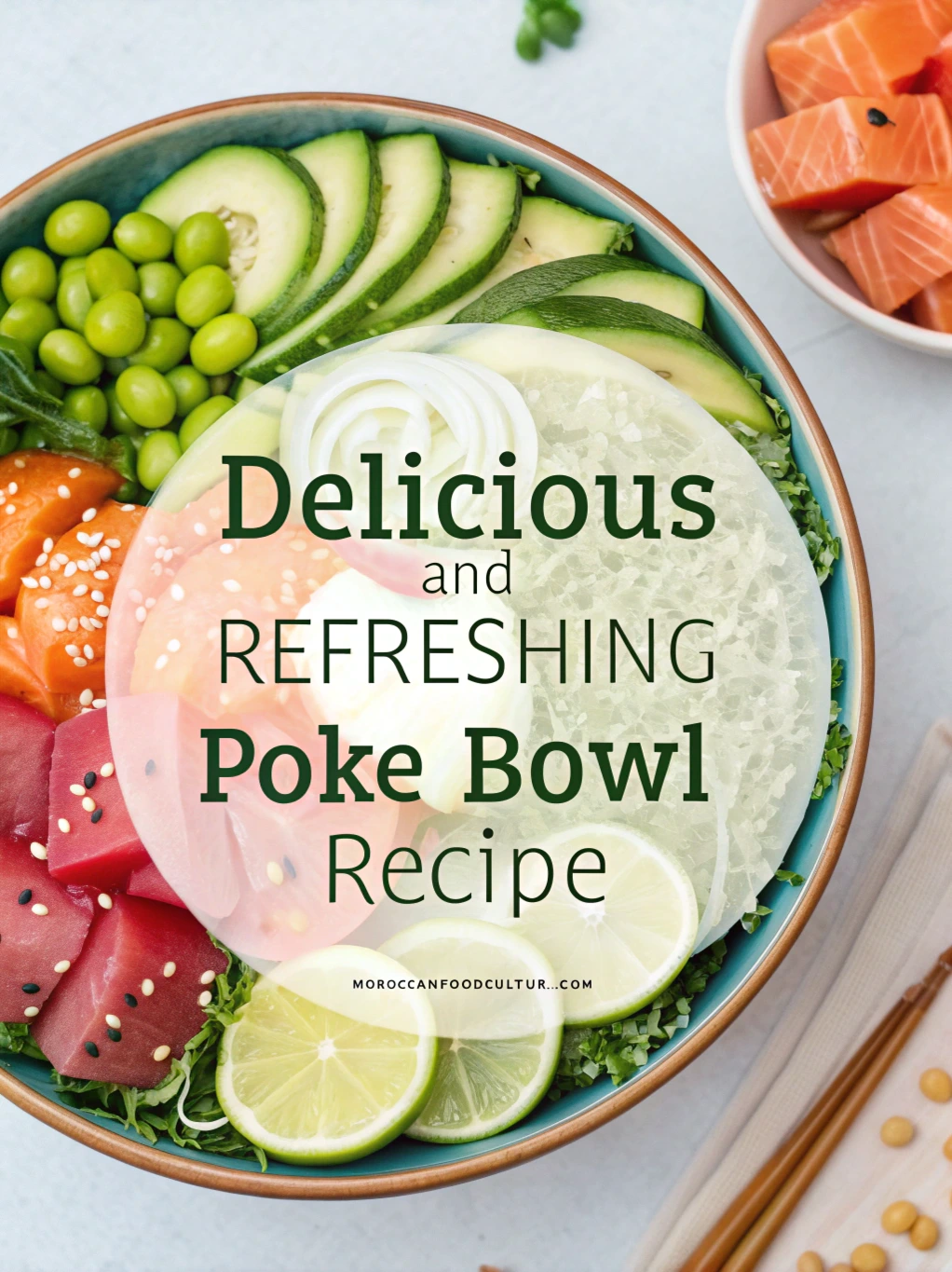The Ultimate Poke Bowl: A Delicious and Refreshing Hawaiian-Inspired Recipe
Have you ever experienced that moment when the perfect bite of food transports you thousands of miles away? That’s precisely what happened the first time I tasted a properly crafted poke bowl. The symphony of textures dancing across my palate—tender cubes of fish marinated to perfection, the subtle chew of perfectly cooked rice, the crunch of fresh vegetables, all brought together with a sauce that somehow managed to be both bold and nuanced.
After a particularly exhausting workday several summers ago, I found myself craving something substantial yet light, nourishing yet exciting. That evening, instead of succumbing to my usual takeout habits, I ventured into a small Hawaiian-inspired eatery that had recently opened in my neighborhood. The poke bowl I ordered changed everything. The vibrant colors, the fresh ingredients, and that perfect balance of flavors instantly whisked me away to sun-drenched beaches and crystal-clear waters.
That single meal sparked an obsession that led me down a rabbit hole of research, experimentation, and countless kitchen adventures. Today, I’m sharing my journey to creating the perfect poke bowl at home—a dish that has since become my go-to meal for quick weeknight dinners, meal prep solutions, and even impressive entertaining. Ready to discover how this Hawaiian treasure can revolutionize your kitchen repertoire? Let’s dive in.
Table of Contents
What Is a Poke Bowl? Understanding the Hawaiian Classic
The Rich Cultural History of Poke
To truly appreciate the poke bowl that’s conquered international food scenes, you must first understand its humble beginnings. The word “poke” (pronounced POH-kay) comes from the Hawaiian language, meaning “to slice” or “cut crosswise into pieces.” This perfectly describes the preparation of the dish’s star component—cubed raw fish.
Long before tourists flocked to Hawaiian shores, native fishermen would prepare freshly caught fish, cube it, and season it with sea salt, limu (seaweed), and crushed kukui nuts (called inamona). This simple preparation made for a practical, protein-rich snack that utilized the bounty of the surrounding ocean.
What we recognize today as the modern poke bowl began taking shape in the 1970s when various influences—particularly Japanese culinary techniques and ingredients—began intermingling with traditional Hawaiian preparation. The addition of soy sauce, green onions, and sesame oil transformed this fisherman’s snack into something entirely new yet respectful of its origins.
By the mid-2010s, poke had spread to the mainland United States and beyond, evolving further with each mile traveled from its birthplace. What began as a simple preparation of fresh fish has transformed into an endlessly customizable bowl that maintains its Hawaiian soul while embracing global influences.
The Essential Elements of an Authentic Poke Bowl
Understanding the fundamental components of a poke bowl will empower you to create balanced, delicious variations while honoring the dish’s heritage:
- Base: Traditionally short-grain white rice, though contemporary versions might include brown rice, quinoa, or even greens for a lower-carb option
- Protein: Classically raw ahi tuna, though salmon, hamachi (yellowtail), cooked shrimp, or even tofu for plant-based alternatives have become widely accepted
- Toppings: Fresh vegetables and fruits that provide textural contrast and visual appeal—cucumber, avocado, edamame, mango, radish, and more
- Crunchy elements: Adding textural dimension through components like furikake (Japanese seasoning), tobiko (flying fish roe), fried garlic chips, or macadamia nuts
- Sauce: The dressing that ties everything together, typically featuring soy sauce or ponzu as its backbone, enhanced with sesame oil, rice vinegar, and other flavorings
While contemporary poke bowls have strayed considerably from traditional Hawaiian preparation, understanding these core elements allows you to innovate thoughtfully, creating versions that respect tradition while embracing personal preferences and ingredient availability.

Selecting the Freshest Ingredients for Your Poke Bowl
Finding Sushi-Grade Fish for the Perfect Poke
The foundation of an extraordinary poke bowl begins with impeccable fish. Since you’ll be consuming it raw, quality isn’t just about flavor—it’s about safety.
When shopping for fish destined for your poke bowl, you’ll likely encounter the term “sushi-grade” or “sashimi-grade.” These descriptions, while not regulated by any governing body, generally indicate fish that has been frozen at temperatures low enough to kill potential parasites, making it safe for raw consumption.
Here’s what to look for when selecting fish for your poke:
- Appearance: The flesh should be vibrantly colored (deep red for tuna, peachy-orange for salmon) with no browning edges
- Smell: Truly fresh fish has a clean, oceanic scent—never fishy or ammonia-like
- Texture: The flesh should be firm, resilient, and spring back when gently pressed
- Source: Develop a relationship with a reputable fishmonger who can advise on the freshest options and proper handling
When purchasing fish for poke, communicate your intentions to the seller. Many specialty fish markets and even some higher-end grocery stores can direct you to appropriate options that have been handled with raw consumption in mind.
For those concerned about sustainability, resources like the Monterey Bay Aquarium’s Seafood Watch can guide your purchases toward environmentally responsible choices—a small but meaningful way to ensure future generations can enjoy the same oceanic bounty we treasure today.
Seasonal Vegetables and Fruits to Enhance Your Poke Bowl
While the protein might be the star, the supporting cast of fresh produce elevates a good poke bowl to greatness. Embracing seasonal vegetables and fruits not only ensures peak flavor and nutritional value but also connects your meal to the natural rhythms of the growing season.
In spring and summer, consider incorporating:
- Ripe avocado slices
- Persian cucumber ribbons
- Sweet mango cubes
- Crisp watermelon radish rounds
- Tender microgreens
- Fresh corn kernels
When autumn and winter arrive, transition to:
- Thinly sliced persimmon
- Pomegranate arils for bursts of juicy brightness
- Roasted sweet potato cubes
- Pickled daikon radish
- Sautéed shiitake mushrooms
- Crisp jicama sticks
Year-round staples that form the backbone of excellent poke bowls include:
- Edamame
- Shredded carrots
- Sliced jalapeños (for heat lovers)
- Diced green onions
- Shredded cabbage (purple or green)
- Sprouts for added texture and nutritional punch
When selecting produce, consider both flavor pairings and visual impact. The most irresistible poke bowls appeal to the eye first—a rainbow of ingredients thoughtfully arranged in a manner that makes you eager to dive in with both utensil and camera.
Essential Kitchen Tools for Poke Bowl Preparation
Crafting restaurant-quality poke bowls at home doesn’t require professional equipment, but several key tools will significantly enhance your experience:
| Tool | Purpose | Recommended Type |
|---|---|---|
| Sharp Knife | Clean cutting of fish | Chef’s knife or santoku |
| Cutting Board | Separate board for fish | Plastic, dishwasher-safe |
| Mixing Bowls | Marinating and serving | Glass or ceramic |
| Rice Cooker | Perfect rice every time | Electric with timer function |
| Citrus Juicer | Fresh juice for marinades | Hand juicer or reamer |
| Mandoline | Uniform vegetable slices | Adjustable with hand guard |
| Shallow Serving Bowls | Attractive presentation | Wide ceramic bowls |
A truly sharp knife deserves special emphasis—dull blades tear rather than slice, damaging the delicate texture of raw fish. Consider investing in a quality knife sharpener or having your knives professionally serviced several times yearly.
For food safety, dedicate a separate cutting board exclusively for raw fish preparation. Plastic boards are preferable as they can be sanitized in the dishwasher, minimizing cross-contamination risks between different food preparations.
The Ultimate Poke Bowl Recipe: Step-by-Step Guide
Preparing the Perfect Rice Base
Rice Selection and Cooking Tips
The foundation of your poke bowl deserves thoughtful preparation. While Japanese-style short-grain rice traditionally forms the base of most poke bowls, your choice should reflect both personal preference and nutritional goals.
Short-grain rice releases more starch during cooking, creating that subtly sticky texture that holds together nicely and captures traces of the flavorful sauces that will eventually dress your bowl. Medium-grain varieties offer a middle-ground approach, while long-grain rice provides a fluffier, more separate texture that some prefer.
For perfect rice every time:
- Rinse your rice thoroughly until the water runs clear—this removes excess starch and prevents gumminess
- Use the appropriate water-to-rice ratio (typically 1:1 for short-grain in a rice cooker, 1.5:1 for stovetop)
- Allow the cooked rice to rest, covered, for 10-15 minutes after cooking
- Gently fold in rice seasoning (optional) while still warm
For traditional Japanese-style seasoned rice, combine 2 tablespoons rice vinegar, 1 tablespoon sugar, and 1 teaspoon salt per 2 cups of cooked rice. This subtle seasoning complements the other flavors in your poke bowl without overwhelming them.
For those seeking alternatives, cauliflower rice offers a lower-carb option, while quinoa provides additional protein and a pleasant nutty flavor that pairs beautifully with many poke combinations.
Marinating Your Protein Like a Pro
Classic Ahi Tuna Poke Marinade
The marinade transforms raw fish into the centerpiece of your bowl—infusing flavor while subtly altering texture. The beauty of this process lies in its brevity; unlike other marinades that might work their magic over hours, poke marination happens relatively quickly.
For a classic ahi tuna poke that honors Hawaiian traditions while incorporating Japanese influences:
- 1 pound sushi-grade ahi tuna, cut into ½-inch cubes
- 3 tablespoons premium soy sauce or tamari
- 2 teaspoons toasted sesame oil
- 1 tablespoon rice vinegar
- 1 teaspoon honey or maple syrup
- 1 teaspoon freshly grated ginger
- 1 clove garlic, finely minced
- Optional: ¼ teaspoon red pepper flakes for gentle heat
Combine all marinade ingredients in a bowl before gently folding in the fish. Allow the mixture to marinate for 15-30 minutes in the refrigerator—long enough to impart flavor but not so long that the acid begins to “cook” the fish, altering its prized texture.
This brief marination period highlights the importance of timing in poke preparation. The ideal moment to begin marinating your protein is after you’ve prepared your base and toppings, ensuring everything reaches completion simultaneously for the freshest possible bowl.
Vegetarian and Vegan Protein Alternatives
Plant-based eaters need not miss out on the poke bowl experience. Several alternatives capture the essence of traditional poke while aligning with vegetarian and vegan lifestyles:
Firm Tofu Poke
- Press extra-firm tofu for at least 30 minutes to remove excess moisture
- Cut into ½-inch cubes
- Marinate in the classic sauce above, adding 1 tablespoon nutritional yeast for umami depth
- Optional: briefly bake at 375°F for 15 minutes for a slightly firmer texture
Tempeh Alternative
- Steam tempeh for 10 minutes to remove bitterness
- Cool completely before cutting into small cubes
- Marinate in classic sauce with added 1 tablespoon maple syrup to balance tempeh’s nuttiness
- For enhanced texture, quickly pan-sear marinated cubes before assembling bowl
Roasted Mushroom Option
- Select meaty varieties like king oyster, portobello, or trumpet mushrooms
- Cut into bite-sized pieces, maintaining natural texture
- Toss with olive oil, salt, and pepper
- Roast at 425°F until edges caramelize
- Allow to cool before tossing in marinade
These plant-based proteins absorb flavors beautifully and provide substantial nutritional value, with tempeh offering approximately 16g of protein per 3.5oz serving, comparable to some fish varieties.
Creating the Perfect Poke Bowl Assembly Line
Strategic Layering for Maximum Flavor
The assembly of your poke bowl transcends mere practicality—it’s an exercise in aesthetics and flavor optimization. Each component should be positioned thoughtfully to ensure the perfect bite every time:
- Begin with your rice base, slightly warm or at room temperature, never hot enough to cook the toppings or cold enough to congeal fats in the sauces
- Position your marinated protein slightly off-center, creating a focal point rather than hiding this star ingredient
- Arrange vegetables in color-coordinated sections—consider color wheel principles for visually striking combinations
- Incorporate your crunchy elements last to preserve their textural integrity
- Drizzle additional sauce just before serving, starting at the edges and working inward to ensure even distribution
This approach not only creates an Instagram-worthy presentation but ensures proper temperature and texture in every bite—the hallmark of truly exceptional poke bowls.
Texture and Color Balance Guide
Extraordinary poke bowls engage all senses, with texture and color playing crucial roles in both the eating experience and visual appeal:
| Component | Texture | Color Options | Examples |
|---|---|---|---|
| Base | Soft, Sticky | White, Brown, Green | Short-grain rice, quinoa, mixed greens |
| Protein | Tender, Firm | Red, Pink, Orange, Beige | Tuna, salmon, tofu, tempeh |
| Vegetables | Crisp, Crunchy | Green, Orange, Purple, Yellow | Cucumber, carrot, cabbage, corn |
| Toppings | Crunchy, Crispy | Various | Furikake, fried shallots, sesame seeds |
| Sauce | Smooth, Silky | Dark, Creamy | Shoyu, spicy mayo, ponzu |
When planning your bowl, aim for at least three distinct textures and four different colors. This diversity not only enhances eating pleasure but typically ensures a broader nutritional profile as different colors in vegetables often indicate different phytonutrient content.
Creative Poke Bowl Variations to Try
Regional Poke Bowl Inspirations
While respecting the Hawaiian origins of poke, exploring regional variations can expand your culinary repertoire and introduce exciting new flavor combinations:
Hawaiian Traditional Poke
For the purist seeking connection to poke’s roots:
- Ahi tuna with minimal intervention
- Limu seaweed for oceanic brininess
- Hawaiian alaea salt (distinguished by its reddish hue from volcanic clay)
- Crushed kukui nuts (inamona) for richness
- Simple dressing of soy sauce and sesame oil
- Green onions for subtle pungency
This preparation highlights the pristine quality of the fish above all else—a reminder of poke’s origins as a fisherman’s meal that celebrated the ocean’s bounty with minimal adornment.
Japanese-Inspired Poke
Drawing from Japan’s refined culinary aesthetic:
- Salmon cubes marinated with yuzu citrus for brightness
- Shredded shiso leaves offering minty, herbaceous notes
- Paper-thin slices of pickled ginger
- Wasabi-infused soy dressing applied with restraint
- Tobiko (flying fish roe) for color and textural pop
- Cucumber batons for cooling crunch
This variation emphasizes clean flavors and visual precision, embodying the Japanese principle of letting ingredients speak for themselves.
Korean-Inspired Poke
Embracing Korea’s bold flavor traditions:
- Tuna marinated with gochujang for sweet-spicy depth
- Kimchi adding fermented complexity and probiotic benefits
- Sigeumchi namul (seasoned spinach) offering mineral-rich earthiness
- Crispy rice or mixed multigrain options for textural interest
- Julienned carrots quick-pickled in rice vinegar
- Gochugaru (Korean chili flakes) for distinctive dry heat
The Korean approach introduces pungent, deeply savory elements that transform poke into something entirely new yet harmonious.

Dietary-Specific Poke Bowl Recipes
Modern eating patterns require adaptable recipes that accommodate various nutritional needs without sacrificing flavor:
Low-Carb Poke Bowl Options
For those monitoring carbohydrate intake:
- Cauliflower rice base (approximately 5g net carbs per cup versus 45g in white rice)
- Increased avocado portion for satiating healthy fats
- Higher protein ratio to increase fullness factor
- Low-sugar marinade substituting monk fruit sweetener for traditional honey
- Expanded vegetable selection emphasizing lower-carb options like zucchini and bell peppers
- Macadamia nuts adding crunch with minimal carbohydrate impact
This variation delivers the poke experience without compromising ketogenic or low-carb dietary approaches, proving that nutritional restrictions needn’t limit culinary exploration.
High-Protein Fitness Poke
Designed for active individuals with increased protein requirements:
- Double protein portions featuring a mix of raw and cooked options
- Edamame scattered throughout for plant-based protein complement
- Quinoa-rice blend base offering complete protein profile
- Greek yogurt-based sauce incorporating protein powder
- Hemp hearts sprinkled for additional protein and omega fatty acids
- Strategic macronutrient balance supporting muscle recovery and growth
This protein-packed variation yields approximately 40-45g protein per serving, positioning poke as an ideal post-workout meal that refuels without excessive heaviness.
Health Benefits of Regular Poke Bowl Consumption
The poke bowl’s rise to international fame isn’t merely about flavor trends—it represents a comprehensive approach to nourishment that aligns with contemporary understanding of optimal eating patterns.
Nutritional Breakdown of a Balanced Poke Bowl
Each component contributes unique nutritional attributes, creating a remarkably complete meal:
| Component | Key Nutrients | Health Benefits |
|---|---|---|
| Fish | Omega-3 fatty acids, complete protein, vitamin D | Reduced inflammation, improved mood, cardiovascular support |
| Rice | Complex carbohydrates, B vitamins | Sustained energy release, nervous system support |
| Avocado | Monounsaturated fats, vitamin E, potassium | Brain health, skin integrity, blood pressure regulation |
| Seaweed | Iodine, fucoxanthin, unique mineral profile | Thyroid function, metabolic support, antioxidant protection |
| Colorful Vegetables | Diverse phytonutrients, vitamin C, fiber | Immune enhancement, digestive health, cellular protection |
A standard poke bowl delivers approximately 400-600 calories depending on portions and specific ingredients, with remarkably balanced macronutrient distribution—typically 45% carbohydrates, 30% protein, and 25% healthy fats. This natural balance explains the satisfied-yet-energized feeling many experience after enjoying this meal.
Calorie and Macro Considerations for Different Dietary Goals
The inherent flexibility of poke bowls allows easy adaptation for various nutritional objectives:
For weight management:
- Increase vegetable proportion
- Moderate rice portion (½ cup cooked)
- Standard protein portion (4oz)
- Focus on circulation-boosting spices like ginger and cayenne
- Total calorie range: 350-450 calories
For muscle building:
- Increase protein portion to 6-8oz
- Maintain normal rice portion (1 cup cooked)
- Add protein-rich toppings like edamame
- Include recovery-supporting ingredients like ginger and turmeric
- Total calorie range: 550-700 calories
For heart health:
- Emphasize omega-rich fish like salmon
- Include plenty of avocado for monounsaturated fats
- Incorporate seaweed for potassium and magnesium
- Add garlic to marinade for cardiovascular benefits
- Select brown rice over white for additional fiber
- Total calorie range: 400-550 calories
This adaptability ensures poke bowls can remain a nutritional cornerstone through different life stages and wellness goals.
Poke Bowl Meal Prep: Make-Ahead Tips and Storage
The efficiency of modern life often necessitates advance preparation. Fortunately, poke bowls lend themselves beautifully to partial meal preparation without compromising quality.
Batch Cooking Components for Weekly Poke
Strategic preparation of individual components saves time while preserving freshness:
- Rice preparation: Cook larger batches, portion into containers, and refrigerate for up to 4 days. Reheat portions with a sprinkle of water in the microwave.
- Vegetable preparation: Pre-cut hardy vegetables like carrots, radishes, and cabbage up to 3 days ahead. Store in water-filled containers for maximum crispness.
- Sauce creation: Prepare marinades and dressings up to 5 days ahead, storing in glass jars with tight-fitting lids.
- Protein handling: Purchase fish the day you plan to consume it. For alternative proteins like tofu, prepare up to 2 days ahead.
This component approach allows for quick assembly while ensuring each element maintains its ideal texture and flavor profile.
How to Pack the Perfect Poke Bowl for Lunch
Taking poke to work or school requires thoughtful container strategy:
- Select sectioned containers with secure lids to keep components separate until consumption
- Place rice at the bottom, adding a sheet of parchment paper before adding other components
- Position marinated protein in its own section to prevent liquid migration
- Pack sauces in separate small containers to add just before eating
- Include an ice pack when transporting to maintain safe temperature
- Assemble just before eating, ideally allowing contents to reach room temperature for 10-15 minutes
These techniques transform poke from merely restaurant fare to a practical, everyday luxury that elevates mundane lunch breaks into mini culinary vacations.
Conclusion: Why Poke Bowls Deserve a Regular Spot in Your Meal Rotation
The poke bowl isn’t merely another food trend destined for culinary obscurity—it represents an ideal intersection of nutrition, convenience, versatility, and pure eating pleasure that earns it lasting relevance in contemporary kitchens.
What began as a humble Hawaiian fisherman’s preparation has evolved into something greater: a customizable vessel reflecting personal taste while honoring culinary tradition. The balance of protein, healthy fats, complex carbohydrates, and vibrant vegetables delivers sustained energy without heaviness—the culinary embodiment of “feel good food” that nourishes both body and spirit.
Whether you’re an experienced home cook seeking kitchen adventure, a nutrition enthusiast looking for balanced options, or simply someone who appreciates beautiful food, the poke bowl offers something remarkable. The simple techniques outlined here open endless possibilities for personal expression through food, turning everyday meals into opportunities for both nourishment and joy.
So gather your fresh ingredients, sharpen your knife, and embark on your own delicious poke journey. Your taste buds—and well-being—will thank you with every colorful, flavor-packed bite.
Ready to elevate your homemade meals? Start with this poke bowl recipe tonight and discover why this Hawaiian-inspired dish has captured culinary hearts worldwide. Then share your creations with friends and family—spreading the poke love one vibrant bowl at a time.
FAQ About Delicious and Refreshing Poke Bowl Recipes
Is it safe to eat raw fish in a poke bowl at home?
Yes, preparing poke bowls with raw fish at home is safe when you follow proper guidelines. Purchase sushi-grade fish from reputable fishmongers or specialty markets—these suppliers ensure their products have been properly frozen to kill potential parasites according to FDA guidelines. Keep your fish refrigerated until preparation time, use separate boards and utensils for fish preparation, and consume within 24 hours of purchase for the freshest poke bowl experience. If you’re pregnant, immunocompromised, or particularly concerned about raw consumption, consider lightly searing the exterior of your fish or exploring fully cooked protein alternatives.
What’s the best rice to use for an authentic poke bowl?
Traditional Hawaiian poke bowls typically feature short-grain white rice, similar to Japanese sushi rice. This variety contains higher amylopectin starch content, creating that subtly sticky texture that holds together beautifully and captures flavorful sauces. For authentic preparation, rinse your rice thoroughly before cooking, then season lightly with rice vinegar, salt, and a touch of sugar while still warm. If you’re seeking healthier alternatives without sacrificing the poke bowl experience, consider brown short-grain rice, forbidden black rice, or even cauliflower rice for a lower-carb option—each offering unique nutritional benefits while still providing that crucial foundation for your delicious poke bowl creation.
Can I make a poke bowl without fish?
Absolutely! While traditional poke bowls showcase raw fish, numerous delicious alternatives exist for those avoiding seafood. Firm tofu marinated in classic poke seasonings delivers excellent flavor absorption and protein content. Tempeh offers a nuttier alternative with probiotics and complete protein. For those who enjoy seafood but prefer cooked options, consider quickly seared tuna, poached shrimp, or even flaked smoked salmon. Plant-based eaters might explore roasted mushrooms—particularly king oyster or trumpet varieties—which provide meaty texture and umami depth. The key to creating fantastic fish-free poke bowls lies in maintaining that balance of textures, flavors, and colors that makes traditional versions so appealing.
How far in advance can I prepare ingredients for my poke bowl?
For optimal freshness and food safety, different poke bowl components require different preparation timelines. The fish component should be marinated no more than 30 minutes to 2 hours before serving to prevent texture changes from acid “cooking.” However, many other elements can be prepared well in advance: rice can be cooked and refrigerated up to 4 days; sturdy vegetables like carrots and radishes can be prepped 2-3 days ahead; sauces and marinades often improve with 1-2 days of flavor melding. Store components separately in airtight containers, combining everything just before serving. This preparation strategy makes poke bowls an excellent meal prep option—simply assemble fresh components at mealtime for restaurant-quality results with minimal weekday effort.
What makes a poke bowl different from other rice bowls or sushi?
The poke bowl’s distinctive character comes from several key elements separating it from other seemingly similar dishes. Unlike chirashi or deconstructed sushi, poke features marinated rather than plain raw fish, creating deeper flavor penetration. The Hawaiian preparation traditionally incorporates indigenous ingredients like limu seaweed and inamona (crushed kukui nuts), reflecting its Pacific Island heritage. While donburi (Japanese rice bowls) might seem comparable, they typically feature cooked proteins and different seasoning profiles. Contemporary poke bowls embrace customization and fusion elements not found in more tradition-bound preparations. Perhaps most significantly, poke represents an accessible entry point to raw fish enjoyment—less technically demanding than sushi while delivering similar nutritional benefits and pure flavor expressions.
Have you given our recipe a try?
There are no reviews yet. Be the first one to write one.




